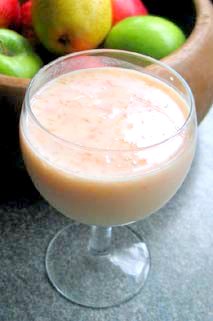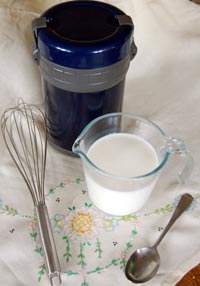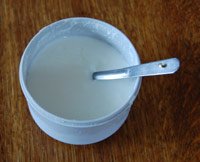How to Make Yogurt at Home in a Flask

How to make yogurt - easy and cheap!
Yogurt is quite easy to make at home. If you just want to make yogurt, probably the easiest all round solution is to buy a yogurt maker and just follow the instructions!
But maybe you want to be more independent of the electricity supply. Or, maybe you just want to know how to make yogurt because you are curious as to how it's done - or because you just can't get enough of this fabulous healthy food!
Whatever the reasons, here is a very simple guide to making yogurt at home without the aid of a yogurt maker, or even electricity. You can use commercial yogurt starters - or not. While these are much easier to find than formerly, yogurt cultures from the yogurt in your fridge will usually serve nicely to begin with.
If you want to live a healthier and greener life, learning how to make yogurt is another good skill to have. And homemade yogurts can be just as delicious as factory made ones.
If you want to read a little more about the whys and wherefores of eating yogurt, please see fermented foods.
Here's what you need to make yogurt at home

A good quality vacuum flask, preferably a wide mouthed one is perhaps the easiest vessel to choose for making yogurt. If you live in a very warm country you might not even need that. I have seen yogurt made in bowls in India without any artificial heat.
Next, you need a supply of milk. You can use cow's milk, goat's milk or sheep's milk. I'm sure camel's milk is entirely possible but I've not tasted it so far! You can make yogurt at home using any or all of the common types of milk on sale, including soy milk.
Most, essentially, you need some yogurt as a starter. Use fresh, good quality natural yogurt from a reputable source. Avoid any with thickeners or other additives as the culture may be dead or nearly so.
You can also buy good yogurt starters in health food shops and specialist shops.
You also need bowls or a mixing jug and spoons. A whisk is handy. A hot drink vacuum flask will work just as well as a wide-necked one - it's just harder to clean.
That's it!
Picture, above: This is all you really need to make yogurt - apart from the yogurt starter
How to make yogurt:
Temperature control
Yogurt needs to be kept at around 100 degrees Fahrenheit, or slightly better, in order to culture a batch of milk.
Yogurt was almost certainly discovered by people carrying milk in animal skins. A combination of wild cultures and continual warmth would have supplied the necessary conditions for yogurt to develop.
How to make yogurt:
Which milk to use
The milk can be full-fat cow's milk or half-skimmed or fully-skimmed. There is a tendency for everyone to want skimmed-milk yogurt as it is seen as healthier.
Full-fat yogurt is generally less than 10 percent fat so it can find a place in most people's diets. It does tend to have a richer, fuller flavour. A richer yogurt can be made by adding dried milk to full or half-fat milk.
You can also use soy milk if you like. I haven't yet tried to make yogurt at home with any of the nut or grain milks.
Here's how to make yogurt just using a common or garden vacuum flask to keep it warm.
Sponsored links
How to make yogurt in a vacuum flask
Take the yogurt you are going to use as starter out of the fridge or cooler the day before you want to make yogurt. This lets the yogurt come up to room temperature. (This is optional, if you start with the milk temperature slightly high - but be careful not to over-do it and kill the culture!)
Measure your flask so that you know how much liquid can be accommodated. Measurements here are for a flask of one pint.
Heat just under a pint of fresh milk on the stove. Bring it up to just below boiling point and then let it cool to around 100 degrees Fahrenheit. A thermometer is useful but not strictly necessary. The milk should feel just slightly warm to touch. Blood heat is around 37 degrees Centigrade (98.4 F). If you drop a drop of milk on the back of your hand it should not feel noticeably hot or cold. Anywhere from 95 to 105 degrees F is fine.
A note on sterilisation
If you prefer to take no chances, it's best to sterilise the milk first.
To do this, heat the milk to just under boiling point. Keep it at this temperature for a couple of minutes, stirring to prevent burning, and then let it cool to around 100 degrees.If you are making yogurt for young children, or frail or elderly folk it is always advisable to sterilise first.
(You can, of course, make yogurt without sterilising the milk - just warm it slowly so as not to overheat it. When it gets to around 100 degrees F just turn off the heat and proceed as follows. I have tried this but I'm not sure the yogurt is as good. It's your choice.)
Next, take a good spoonful of fresh yogurt (unflavoured) and mix it into the milk. Use a whisk to ensure that the yogurt is well distributed. You are not actually whisking it, just mixing it thoroughly. A fork will do if you haven't a whisk.
Pour the milk and yogurt mix into a wide-necked thermos and make sure that the lid is tightly stoppered. Wrap the flask in a towel to minimise heat loss through the lid. Put the flask in a warm place such as an airing cupboard or above the boiler.
In about 24 hours your yogurt should be ready. If conditions are not ideal it can take longer.
If you don't have a vacuum flask you can still make yogurt. It's just a bit more fiddly.
How to make yogurt without using a flask

Warm the milk and mix in the yogurt just as in the flask method described above.
Transfer the yogurt mix into a pot with a sealed lid.
Set the pot of warmed milk and yogurt into a large bowl of warm water at around 100 degrees F or slightly more. The water should come up to the level of the yogurt mix. Put a lid on the bowl of water if you can.
Insulate the bowl with a towel or some other material to help the heat stay in the milk. When the surrounding water goes tepid, replace it with a fresh batch of warm water. You will need to repeat this process at least three or four times before the yogurt develops - unless you are in a warm country.
Some people may be able to make yogurt in the oven or in a slow cooker. You need a source of heat that can be kept at below 120 degrees Fahrenheit. Above that temperature the culture will die.
You can also use the warmth from your stove to help keep the culture warm. Make yogurt when the stove is going to be in use for an extended period and keep the culture somewhere on the stove top or nearby.
If after reading all this you think you would rather buy a yogurt maker, there is a wide selection available on Amazon (US site).
Sponsored links
Straining the yogurt
Some of the nicest yogurts are made from a yogurt culture which is then strained. Use a piece of muslin or cheesecloth and let the excess liquid drip though at its own pace. This liquid is whey and can be used in other recipes. You can also add it to your compost or bokashi bin or give it to the dog to drink.
Greek yogurt - which attracts premium prices in supermarkets, is made by straining fresh yogurt in much this way. The real deal is made using sheep's milk, of course.
Your yogurt will tend to separate into thick yoghurt curd and whey after a little time in the fridge. You can just stir the whey back into the yogurt if you like.
Keeping homemade yogurt
You can store your yogurt in the fridge or other cool place for a week or two. Always smell and taste a little before using lots of it in a dish. Yogurt can go off before obvious signs of mould arrive. Having said that, it generally keeps really well. It will tend to get a little more acidic-tasting before it goes off. So that's the time to make more. It only takes about 6 - 8 hours if you get the temperature high enough.
Buy new starter yogurt every second batch. This helps avoid contamination with stray cultures.
If you want your yogurt to thicken up, incubate it for longer and transfer it to the freezer for a few hours. Avoid motion as this tends to make the yogurt become thinner. You will also get a thicker yogurt if you add some dried milk to your milk at the beginning. I usually add a good heaped dessertspoon and mix it well in to the milk.
How to make yogurt using different cultures
You can now buy probiotic cultures and special types of active lactobacilli to make your home yogurt. Dried preparations are available in specialist shops and some health food shops. There's no doubt that many of these probiotic cultures can be a valuable addition to your diet.
Learning how to make yogurt is easy. Perfecting the art is a little more tricky!
How to Make Yogurt - top of page
Organic Healthy Recipes
Greenfootsteps Home - for more easy green living ideas
How to Make Yogurt in a Flask Copyright Greenfootsteps.com 2008
Please do not copy without permission. This site is protected by Copyscape
| Tweet |

| Tweet |

Sponsored links
On other pages
Other pages related to yogurt and yogurt recipes which may interest you:
Yogurt Drinks to Keep You Cool All Summer Long
Footprints
- an occasional e-zine from Greenfootsteps
If you would like to receive the e-zine, please just sign up below.






New! Comments
Have your say about what you just read! Leave me a comment in the box below.